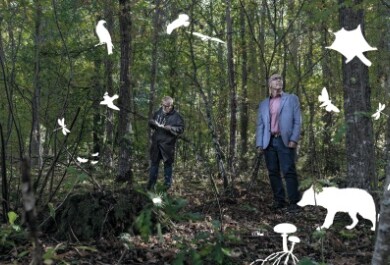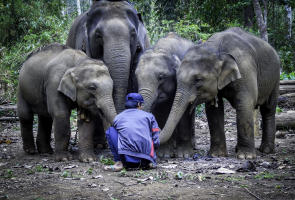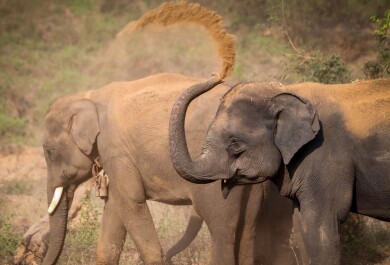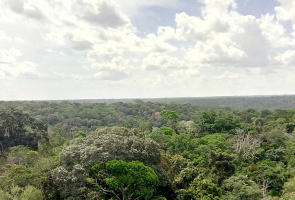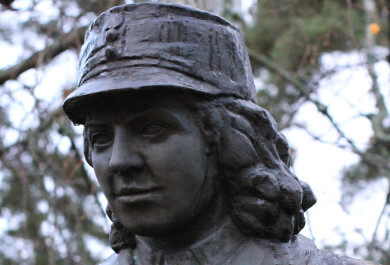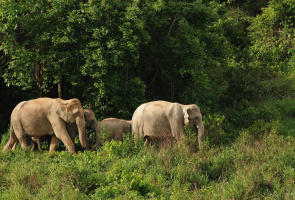Research at the Department of Biology
We have a strong, versatile and internationally recognized research agenda in ecology, animal physiology, genetics and evolutionary biology. Many of our research projects integrate over the levels of biological organization and involve multi-disciplinary collaborations.
Our strength is strong and ambitious basic research that can provide novel and unforeseen perspectives and solutions into societal challenges e.g. in nature conservation or in medicine.
Our multifaceted applied research tackles global change and uses integrative methodology, for example molecular genetics when exploring ecosystem function. A good example is resolving changes in physiological functions of individuals – using cell- and molecular biology methods – as a response to environmental change in the Baltic Sea ecosystem.
Our strong research fields include
- human biological and cultural evolution
- tropical ecology
- biotic interactions, particularly plant-herbivore, and predator-prey, in marine and terrestrial communities
- aquatic animal physiology and ecotoxicology
- microbial genetics and evolution
- animal behavior and population ecology
Our research staff includes 9 associate/full professors and about 80 researchers. The Department gains plenty of competitive external research funding and produces over 200 international, peer-reviewed scientific publications yearly.
Some of our research groups
Virpi Lummaa studies natural selection in contemporary human populations. During her term as Academy Professor, Lummaa will investigate how the modern environment itself fuels human evolution and how demographic shifts to low birth and death rates affect the opportunity for selection or specific trait selection. She will use longitudinal demographic data from Finland spanning 350 years and more than twelve generations to look at how the strength and direction of selection on key fitness traits may have changed with the modernisation of societies.
Adj. prof. Tapio Eeva – This project focuses on the effects of air pollution on free-living bird populations. The main goal is to find out which kind of ecological and physiological impacts environmental pollution has on birds. One of the major interests are indirect effects of air pollution on birds, e.g. via pollution-induced dietary changes.
Dr Anne Muola. The project is studying how intrinsic plant defenses can be utilized in plant protection in accordance with the Integrated Plant Protection strategies. Especially the aim is to study plant tolerance that is the ability of plant to mitigate the negative effects of feeding by pest insects. Plant tolerance is not considered to cause selection pressures on pests, and thus, it is considered to be able to provide durable pest control. However, despite its potential, plant tolerance is not well integrated into crop protection strategies. Work is done in collaboration with the Swedish University of Agricultural Sciences
Dr Outi Vesakoski - The BEDLAN Research Group was established in 2009. The multidisciplinary team operates from the University of Turku, the University of Tampere, the University of Helsinki and Uppsala University. The central aim of our research is to investigate patterns and mechanisms in language divergence by applying approaches and methods from evolutionary biology, ecology and geography. One of the aims is to picture the linguistic history of the Uralic speaking area, and ultimately “triangulate” this, i.e. combine into a holistic history of man, in co-operation with geneticists and archeologists.
Signalling in cells and in C. elegans, Adj. prof. Päivi Koskinen - Our group investigates the physiological roles of PIM kinases and their substrates in the regulation of cell growth, metabolism and motility. We also use the C. elegans nematodes to study evolutionarily conserved signalling pathways controlling sensory functions and environmental responses.
Prof. Veijo Jormalainen- Our research focuses on biotic interactions in the littoral environment of the Baltic Sea, particularly on evolutionary ecology of plant-herbivore -interactions and their role in affecting biodiversity. Climate change speeds up eutrophication and causes warming, acidification and desalination. Furthermore, the Baltic Sea is getting new species introductions with an accelerating rate. The effects of such environmental perturbations on marine communities and ecosystem function percolate through the network of biotic interactions. Therefore, understanding ecology of trophic interactions forms the basis for understanding organismal responses to global change.
Doc. Manu Tamminen Environmental microbes - bacteria, archaea and unicellular eukaryotes - typically live in close physical proximity in complex communities, the functional and spatial organization of which remain poorly known. We investigate interactions between the metabolic properties of individual microbes and the spatial organization of the microbial communities. The research promotes, among other things, our understanding of the spreading of antibiotic resistance genes to new bacterial groups. Our research is based on single cell genome sequencing techniques which leverage from next-generation DNA sequencing augmented by innovations from molecular biology as well as bioinformatics.
Doc. Marjo Helander - Glyphosate is the most used pesticide globally. Its herbicidal activity is based on inactivation of an enzyme of the shikimate metabolic pathway, and it thus kills non-selectively herbaceous plants. It has been regarded harmless to animals and humans, because the shikimate pathway does not occur in animals. However, it can be found in many microbes. Thus, glyphosate may affect the microbial activity and modify microbial community of the soil, plants and other interacting organisms. In our project we take advantage of novel technologies to examine microbiota in plants and animals, their interactions in plants via phytohormone signaling pathways, and the effects of glyphosate on secondary plant defense chemicals, plant performance, and performance and well-being of both invertebrate and vertebrate animal model species. Our project is aiming to gain a holistic view of possible glyphosate effects in the (agro)ecosystem.
Prof. Päivi Onkamo - The project aims at getting a whole-genome picture of the ancient inhabitants in North-East Europe: Finland, North-Western Russia, and the Eastern Baltic region. The main questions combine the fields of biology, linguistics and archaeology, and include: Who were the people who lived here in the ancient times? How has the inhabitants’ genetic composition changed over the centuries – and the millennia?
To fulfill these aims, we sequence ancient human remains from North-East Europe. The project is based in the University of Helsinki, Finland, and works in close collaboration with the Max Planck Institute for the Science of human history, Jena, Germany, the University of Zürich, Switzerland.
Doc. Irma Saloniemi - Kevo Tree Line Gardens (MRP) are randomized and replicated experiments originally established in Utsjoki, Inari, Kittilä and Ruissalo in 1970s to study changes in forest line. The trees in the gardens are open-pollinated progenies of single wild trees (origins), mainly birches. There are long term measurements on survival, growth, reproduction and herbivores of early life stages of the presently adult trees. Molecular methods will be used to connect the trees to their progeny in other gardens, and to the herbarium specimens of the juvenile stages and original trees. Research on the trees is focused on their hybridization, evolution and adaptation to global change in northern conditions.
Marjo Helander is studying plant-microbe interactions in natural environments and agroecosystems. Her main research interest has been in grasses and their systemic, seed transmitted endophytic Epichloë fungi. They are using methods from molecular analysis to long-term transplantation experiments across Europe. In applied research, they are searching solutions to boost forage and meadow grass production in changing climate using new endophyte-grass combinations.
Adj. prof. Satu Ramula - We use long-term population and climate data coupled with demographic models to investigate the responses of wild populations (including those of invasive species) to temporally varying environments. We examine, for example, under which conditions increasing temporal variation can be most detrimental or beneficial for organisms.
In this multidisciplinary project, we study biology of hard ticks (Ixodes ricinus and Ixodes persulcatus), prevalences of tick-borne pathogens (e.g. Borrelia bacteria and TBE virus) in tick populations, and tick-borne diseases in Finland.
Dr Tuuli-Marjaana Koski
I am studying how the use of chemical pesticides in strawberry cultivation could be reduced by
1) utilizing of the existing herbivore-resistance traits in plants, and by
2) increasing genetic diversity in cultivations
3) I will also test, how multiple pests affect the berry and runner production of the plants, as well as the susceptibility of berries to fruit-rotting grey mould.
My study species is woodland strawberry (Fragaria vesca), a wild relative to the commercial strawberry cultivars. The work is conducted in collaboration with the "the Strawberry Lab" at Swedish University of Agricultural Sciences (https://www.slu.se/stenberg).
Adj. prof. Hanna Tuomisto - We carry out long-term multidisciplinary research on documenting and understanding the characteristics of tropical rain forests. Research themes include diversity and dynamics of vegetation; distribution and occurrence of plant and animal species and factors affecting these; taxonomy and evolutionary history of ferns and parasitic wasps; understanding the role of geological history in explaining biogeography and evolutionary history in Amazonia; use of remote sensing to map biodiversity at broad extents.
Virpi Lummaa studies the causes of variation in health, survival and reproduction using longitudinal demographic data recorded over the past century, combined with new physiological, physical and behavioural data collected from live individuals. Her research group aim to provide new solutions to elephant management and healthcare in order to optimise the balance between working ability, survival and fertility, and to minimise calf deaths. This will lead to a self-sustaining working population, which will avoid the need to bolster the captive population with elephants captured from the endangered wild population.
Adj. prof. Mikhail V. Kozlov - Until very recently, studies of insect-plant interactions have focused on the severe plant damage that results from insect outbreaks, while paying little attention to the relatively minor damage caused by normal background insect herbivory. We combine meta-analyses of published data, observations and experiments to explore spatial and temporal variations in background herbivory and the effects of below- and above-ground herbivory on the structure and productivity of forest ecosystems. Our current focus is on the global patterns in background plant losses to sap- and root-feeding insects, the links between plant functional traits and insect herbivory, and the top-down control of herbivory.
Adj. prof. Mikhail V. Kozlov - This international project explores the impacts of different kinds of land use (with emphasis on urbanisation and forest management) on the stability of the interactions between plants, plant-feeding insects and insect-feeding birds in different forest types in Finland, Spain, France, Peru and Argentina. We ask whether the factors affecting this stability (and, in particular, the biodiversity) are consistent across the globe. The project helps to identify the factors that impair ecosystem stability and the regions where natural and managed ecosystems are most vulnerable to ongoing environmental changes.
Adj. prof. Elena L. Zvereva - This project, which started in the early 1990s, explores the abiotic (climate, pollution) and biotic (predation, parasitism, competition) factors affecting the population structure and dynamics of a polymorphic leaf beetle, Chrysomela lapponica. Currently, we analyse long-term data on density and colour morph frequencies in populations of this beetle to test the prediction that natural selection for different phenotypes can influence population cycles (Chitty’s hypothesis). At the same time, we explore some extrinsic factors that can affect leaf beetle populations dynamics through changes in colour morph frequencies, such as climate and bird predation. This project furthers our understanding of the interactions between intrinsic and extrinsic factors in the regulation of the population dynamics of polymorphic species.
Adj. prof. Elena L. Zvereva - Over 40 hypotheses concerning the patterns of insect herbivory have been proposed so far, but an explanation for the pronounced variation observed in the levels of plant damage caused by insects remains elusive. We will use meta-analysis to test these hypotheses using all available data on plant damage by different groups of insects at the global scale. We will then integrate the confirmed hypotheses into a coherent whole. This will increase our current understanding of tri-trophic interactions and facilitates predictions of future patterns of plant losses to insects in natural ecosystems.
Adj. prof. Elena L. Zvereva - Our studies have demonstrated that ecological and environmental science suffers from various biases. Our fundamental objective is to evaluate the extent to which different biases associated with scientific research affect our knowledge. In particular, we seek to identify the particular research methods and research fields within environmental sciences that are most prone to biases and the groups of stakeholders most affected by these biases. Our applied objective is to combat the adverse impacts of biases on environmental knowledge by drawing the attention of scientists and decision makers to this bias problem and by educating students about biases in scientific research.
Academy research fellow Suvi Ruuskanen and her group study how individual variation in phenotypic traits is maintained. We investigate how early-life environment explains variation in offspring phenotype and fitness. For example, we study the importance and evolution of maternally-transmitted thyroid hormones. Our goal is to understand how physiologically-regulated traits enable organismal adaptation to changing environmental conditions.
